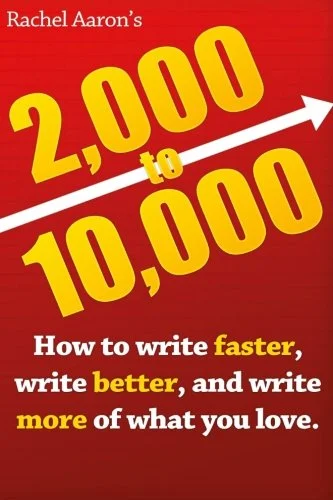A review of
2K to 10K:
Writing Faster, Writing Better, and Writing More of What You Love
by Rachel Aaron.
Let’s get to the good stuff right away: This work made my list of top 10 best books on writing!
Keep reading to find out why. I also list some supplementary and complementary reading and offer a resource of my own that’s a free download.
If you’re pinching pennies it’s only fair to mention that this book is a compilation of key posts from Rachel Aaron’s blog, Pretentious Title (http://thisblogisaploy.blogspot.com). But having it all together and organized is well worth the very affordable asking price. I found all the formats so reasonable that I purchased both the Kindle and Audible versions.
I listen to lots of audiobooks and podcasts as a survival technique in Atlanta’s rush-hour traffic, so the Audible format was the first consumed and is 2 hours 26 minutes in duration. The narrator’s voice (Arial Burnz) was pleasant, and the subtitles and division breaks were fairly obvious from her modulations. The one place where audio didn’t work was a chart in the section titled “BONUS! How I Wrote a Novel in 12 Days.” It’s not a crucial component, and you’ll still get all the essential goodness of the book if your mind goes fuzzy during the recitation of all these numbers. The author kindly makes the chart available on the web at http://rachelaaron.net/audiotools.php so you don’t actually miss out.
Because of the chart, I’d mildly recommend the eBook over the audiobook if you’re going to get only one format. At the time of this review, the audiobook was the least expensive format, the Kindle held the middle ground, with the paperback version following. There is no substantial difference in content between the formats, and if you get both the Kindle and Audible formats they support Whispersync. That is, each remembers your place in the book as you switch between the formats. Also, you can play the narration in the Kindle version and it will highlight the words on the page as they are being spoken, which can help you focus on the content.
That content is, unsurprisingly, exactly what the title suggests: how to be a more productive writer. It reemphasizes the many studies made by the corporate world: planning greatly impacts productivity. While it might seem obvious or instinctual to many, there are plenty of writers trapped in the Writing into the Dark approach or emulating Stephen King’s method and advice to just write it all down and fix it later. That paradigm doesn’t work for everyone, and when it does, it tends to favor seasoned and experienced authors.
But for the budding or frustrated writer, this book includes plenty of encouraging guidance that is well thought out. And Rachel Aaron expands on her premise by examining other factors that contribute to productive writing. And I use the term “productive” in the full sense, because both quality and quantity were the results of Rachel’s methodology. Rachel then uses the second part of the book to give great information on plotting, characters, story structure, and editing. This gives aspiring authors an inside look at the entire writing process of an established novelist. Even writers who subconsciously already understand the concepts espoused by Rachel, will still find it refreshing and encouraging to have them laid out clearly, concisely, and objectively documented.
I would, however, encourage writers to investigate the story structure element further. While the Three-Act structure is incredibly popular and useful, a well-rounded writer should be familiar with different frameworks. Knowing the strengths and weaknesses of each framework equips a writer to adopt a method that fits their personal paradigm, fits the genre, and fits the story type (e.g., character-driven versus action-driven). In addition to previously mentioned Writing into the Dark by Dean Wesley Smith, I’d encourage authors to explore Lester Dent’s Master Plot Formula, Write Your Novel from the Middle by James Scott Bell, How to Write a Novel Using the Snowflake Method by Randy Ingermanson, the Monomyth structure, beat-based frameworks, etc.
While I’m on the topic of supplementary reading, I can’t resist a recommendation to go with Rachel Aaron’s penultimate chapter on editing—my all-time favorite—Self-Editing for Fiction Writers by Renni Browne and Dave King. And speaking of shout-outs, Rachel gives recognition to Scrivener and provides a productivity tracking template that you can download. It’s a very simple fill-in-the-form document to track times and record word counts. I already have a spreadsheet that does all the math for me, so I’ve taken the opportunity to convert it to Google Sheets and share it publicly. Feel free to make a copy and tweak it to fit your needs.
In conclusion, I’d also like to make mention how I came to find this gem. I’d semi-randomly sampled a new book on Audible: Nice Dragons Finish Last by Rachel Aaron. That taste led me to devour the remainder of the Heartstriker series only to find it was, as of then, incomplete. In my search for the expected release date of the next book, I stumbled upon Rachel’s blog and her excellent articles on writing and marketing. That in turn led to her 2K to 10K book. I’d so admired her potting skill in the Hearstriker series, that I had to give 2K to 10K a try and my curiosity was well rewarded. If you’re an aspiring writer—or even an experience writer looking to get better traction—I heartily recommend 2K to 10K.


